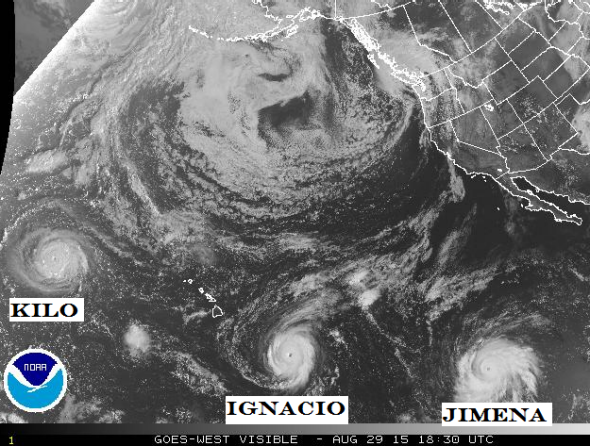This weekend, amid an already record-shattering Pacific tropical cyclone season boosted by a potentially historic El Niño, three simultaneous Category 4 hurricanes lined up like a string of deadly pearls across the Pacific. Such a configuration has never occurred before, at least since the 1850s when reliable records of strong cyclones began.
As seen from the space station on Sunday, Hurricane Jimena was truly massive.
Thankfully, none of these monster storms should affect land, and the center one, Ignacio, has since weakened considerably.
On Monday, another hurricane—Hurricane Fred—became the easternmost forming hurricane in the Atlantic on record, bringing a very rare threat to the Cape Verde islands. It may prove to be the most expensive natural disaster in history on the islands.
But it’s not these storms that have scientists worried. In a study published in the journal Nature Climate Change on Monday, Ning Lin of Princeton and Kerry Emanuel of MIT conclude that, if you factor in the effect of climate change, the risk of truly catastrophic hurricane disasters could increase by more than 10-fold this century.
The new study embeds a high-quality hurricane model into a broader scale climate change model, in an attempt to look at how the worst-case scenario storms may change in the decades to come. The authors call the future megastorms “grey swan” events: Disaster scenarios that aren’t totally unpredictable, like black swan stock market crashes or terrorist attacks, but are still unprecedented.
“What that really translates to is, you’re going to see an increased frequency of the most extreme events,” Emanuel said in a release. “That means you’re going to start seeing hurricanes that you’ve never seen before.”
While the study looked at only three locations—Tampa, Florida; Dubai, United Arab Emirates; and Cairns, Australia—it provides a broader forecast: Storms of unprecedented magnitude will probably happen more often given the effects of climate change. The study doesn’t even factor in the growing effect of sea level rise, which would increase the risk of coastal flooding from these storms even more.
